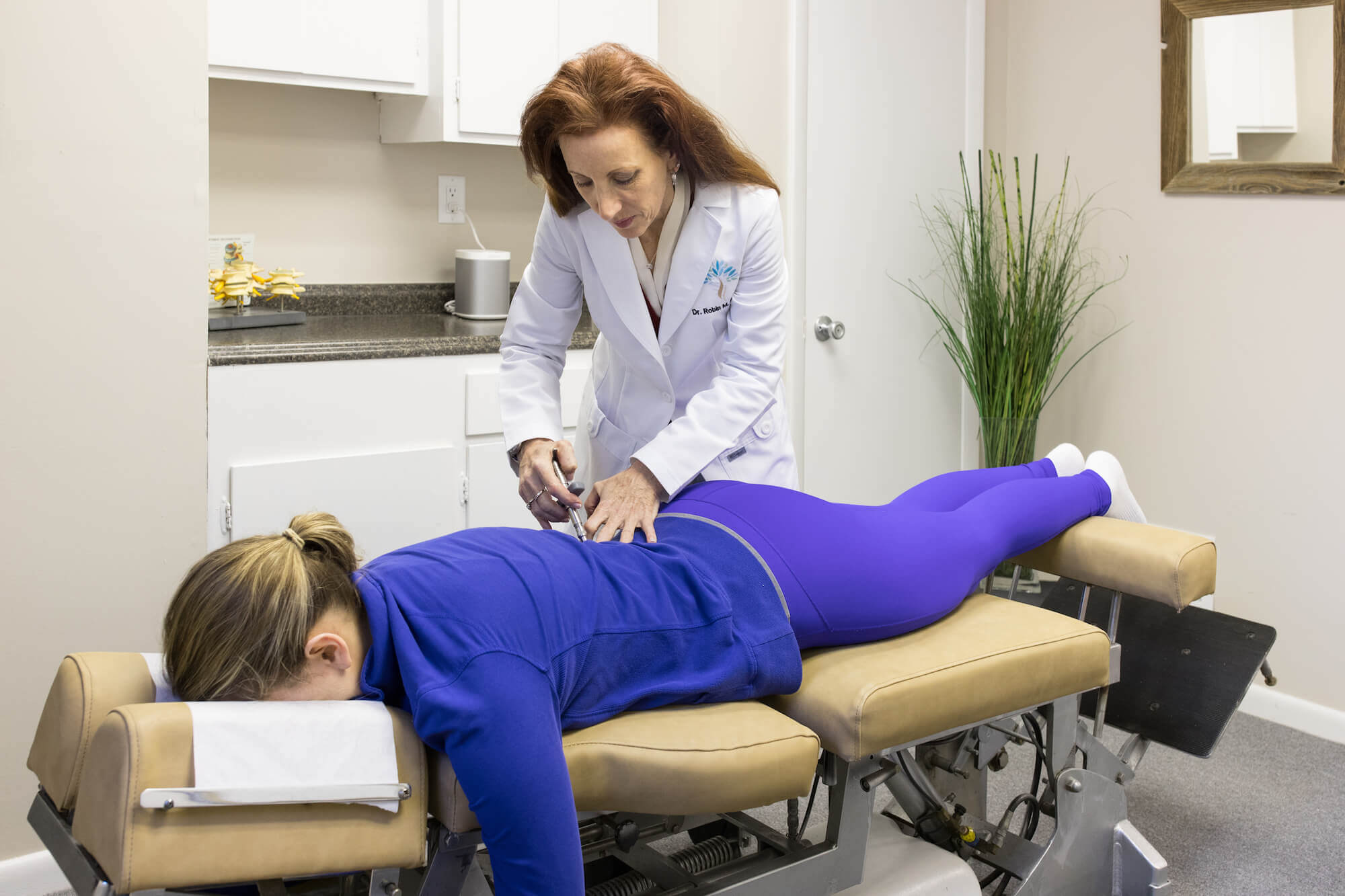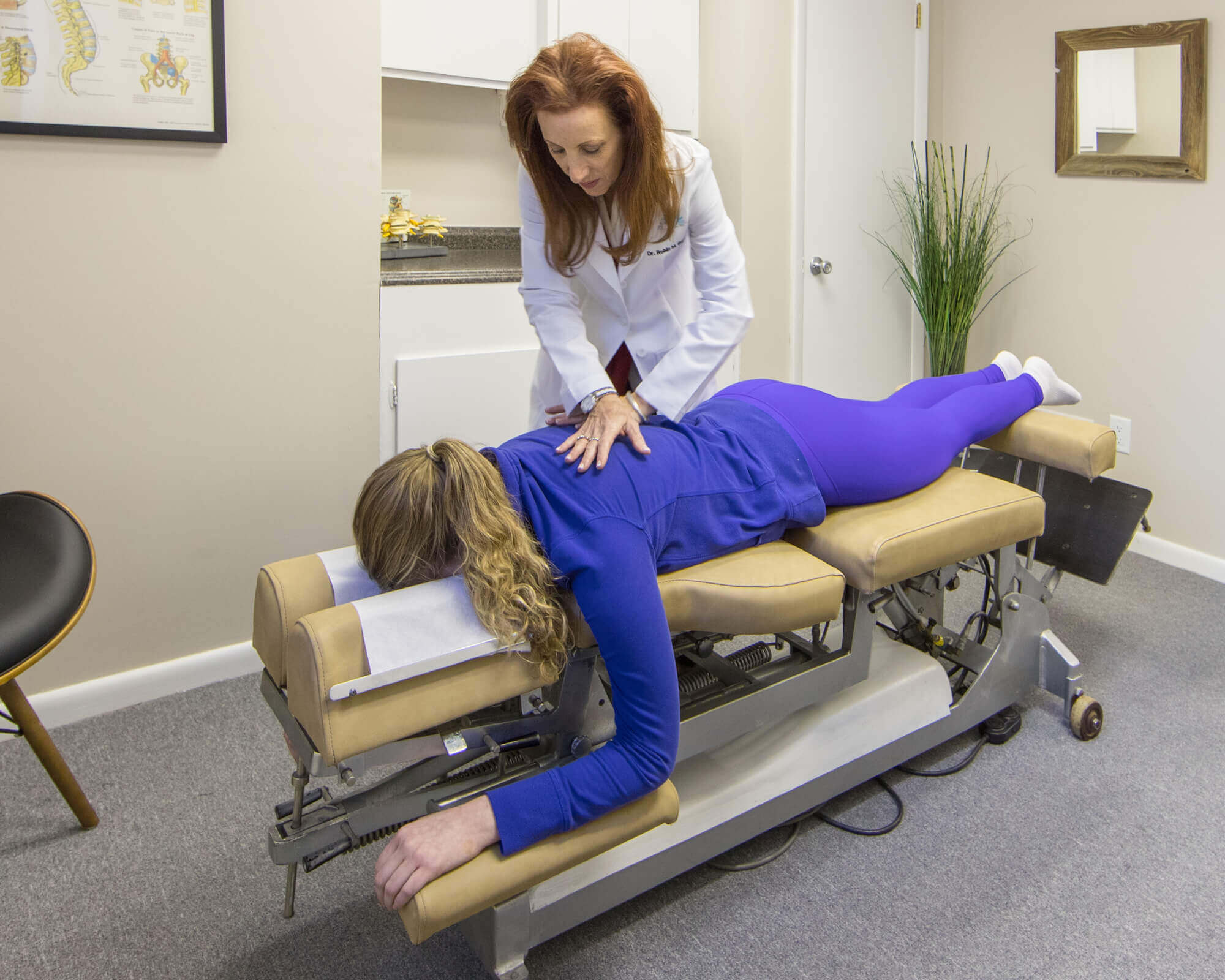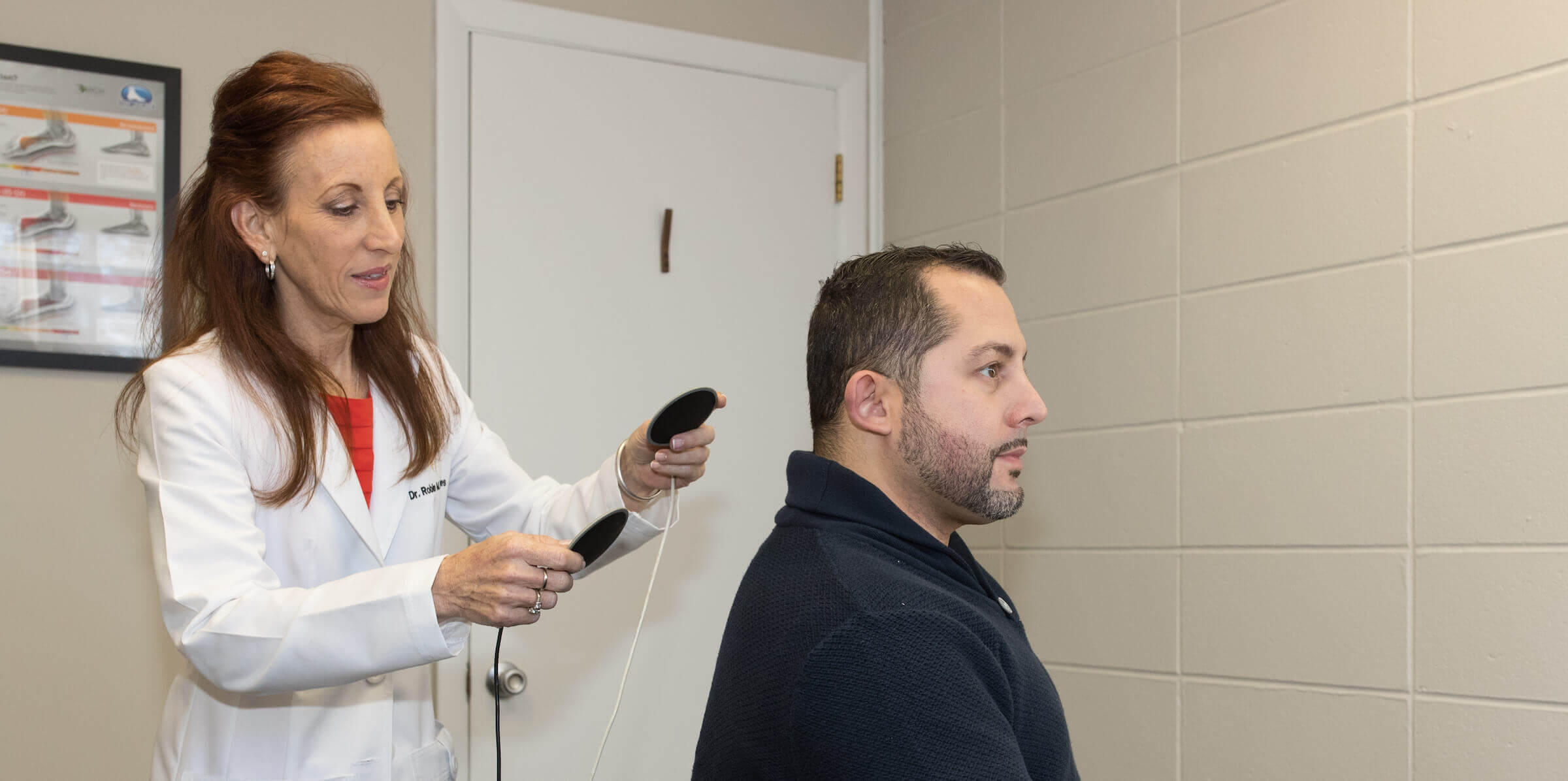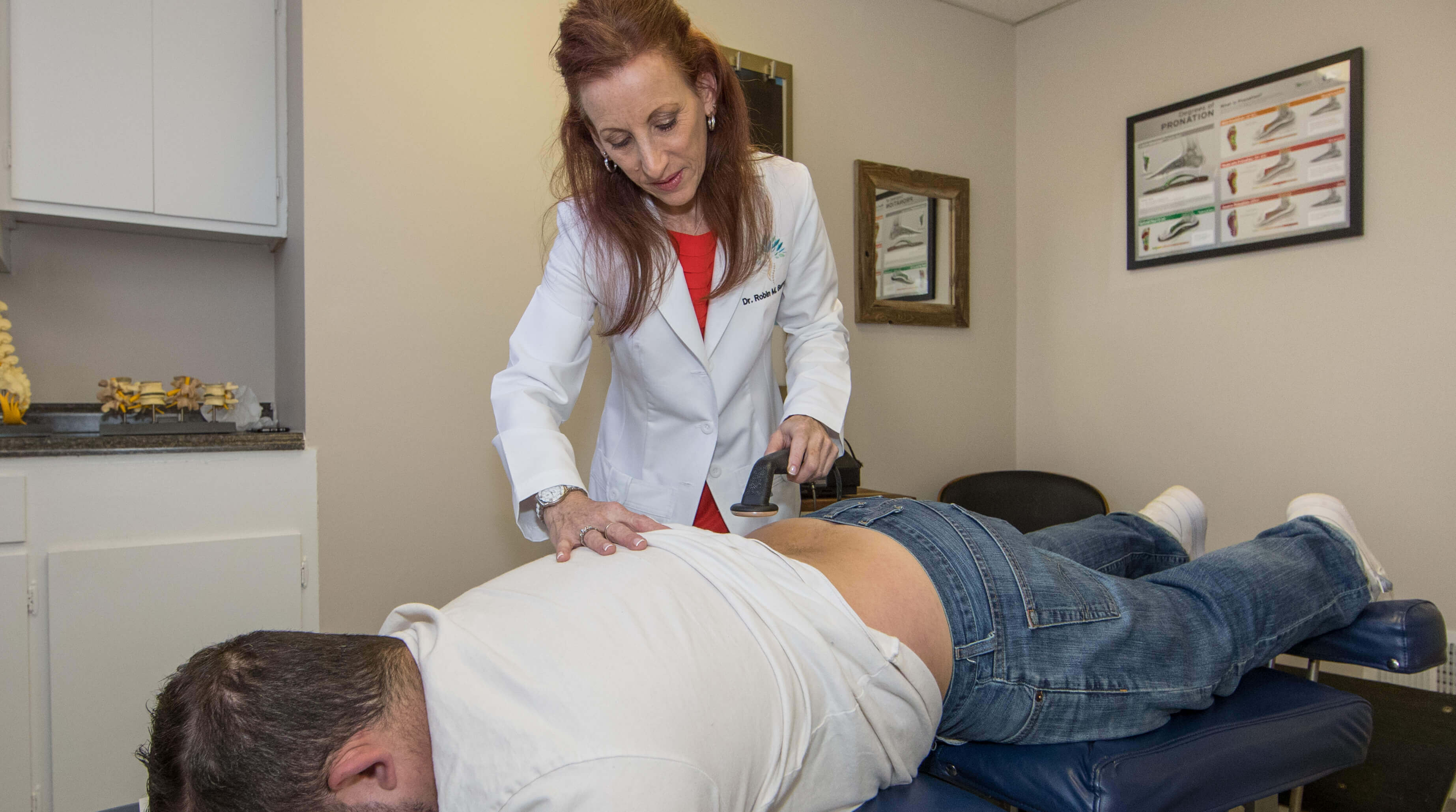Activator Method
The activator method is one way for a chiropractor to perform adjustments. It can be used on its own as an alternative to the traditional diversified method, or the two can be used together.
How does the activator method work?
This method uses a tool called the Activator Adjusting Instrument, often referred to simply as an activator. This instrument is the only device specifically approved by Medicare for use in chiropractic adjustment.
The activator is a small, handheld device, which delivers a concentrated but gentle force to a specific area of the body through a comfortable rubber tip. The chiropractor sets the amount of force used by the device. The force can be customized for each patient, depending on that person’s needs and overall medical situation. Using the activator allows the amount of force used in an adjustment to be precisely controlled, and delivered in a concentrated fashion to a specific area. The original activator is a mechanical, spring-loaded device, and an electronic version is now also available.
One advantage of the activator technique is that it can be gentler than other methods of adjustment. For geriatric patients, who may be frail and may therefore not feel comfortable with spinal manipulation done in the traditional way, the activator method allows them to receive chiropractic adjustments. Because this group of patients commonly experiences pain and stiffness in their joints, many of them are searching for a method of drug-free pain relief. Dr. Barnes is pleased to be able to offer chiropractic treatment to these patients through the activator method.
The activator method can be used alone, or it can be combined with other methods of adjustment. Dr. Barnes commonly uses the activator in conjunction with the diversified technique, in order to provide more effective treatment. The two methods complement each other, and great results can often be achieved by using both methods together.
Is the activator method effective?
The creators of the Activator Adjusting Instrument report 23 published clinical trials that support the effectiveness of this method of chiropractic treatment. The research indicates that the activator method is at least as effective as the traditional diversified technique, which has been used in chiropractic adjustment for decades.
Over half of all chiropractors in the United States report that they use the activator method in their practices. This makes it the second most commonly used chiropractic technique, after the diversified method. The continued use of this method by so many qualified professionals is another indication that it works for patients.
What types of conditions can be treated by the activator method?
The activator method can be used to adjust any part of the body. However, it’s particularly effective at treating particular conditions. Some of the conditions for which we’ve seen excellent results with the activator method include the following:
- TEMPOROMANDIBULAR JOINT DISORDER (TMJ)
- CARPAL TUNNEL SYNDROME
-
RIB HEAD MISALIGNMENT
-
SPINAL MISALIGNMENT
All of these conditions affect sensitive areas of the body, which can benefit from a gentler adjustment technique. Although patients with these conditions are particularly likely to benefit from the activator method, this technique can be used for virtually any chiropractic adjustment. Dr. Barnes uses the activator method in a variety of different clinical situations, either alone or in combination with the diversified technique.
Chester Chiropractic Center
When you come for your first visit at Chester Chiropractic, Dr. Barnes will perform a thorough evaluation. After assessing your condition, she’ll decide whether to use the diversified technique, the activator technique, or both to accomplish your adjustment.
She may also recommend ancillary treatments, such as muscle stimulation or therapeutic ultrasound, to achieve the best results. Dr. Barnes offers all of these scientifically-proven treatments in a relaxing and comfortable environment that facilitates your healing. Contact us to schedule your appointment.
Questions? Ready to schedule an appointment?
Diversified Technique
The diversified technique is the traditional method of chiropractic adjustment. This method of treatment is very popular among chiropractors, because it’s effective at treating a variety of different conditions.
What is the diversified technique?
The diversified technique is a hands-on technique, which uses a carefully placed, high-velocity, low-force manipulation to treat a dysfunctional joint. In other words, the affected joint is treated with a quick, shallow thrust by the chiropractor. The force is carefully placed in the area of dysfunction, and the amount of force is carefully calibrated by the chiropractor to be effective without causing any damage. To gain the clinical experience needed to perform these adjustments skillfully, chiropractors receive years of training at the doctoral level.
In studies, over 95% of chiropractors employ the diversified technique for at least some of their patients. Studies in the U.S., Canada, Australia, and New Zealand all show that diversified is preferred by a majority of chiropractors for treating the majority of patients. This treatment technique is widespread because it works. Chiropractors have seen how effective this method of adjustment can be in getting results for their patients.
Adjustments using the diversified technique can be used on any part of the body, including the spine or the extremities. Scientific research has demonstrated that adjustment using the traditional diversified technique is effective for a variety of conditions, including:
- HEADACHES
- NECK PAIN
- BACK PAIN
- UPPER AND LOWER EXTREMITY JOINT CONDITIONS
- WHIPLASH-ASSOCIATED DISORDERS
- SCIATICA
These are broad categories, and there are a number of specific conditions for which the diversified technique has demonstrated effectiveness.
Which areas can be adjusted?
Your chiropractor can treat any dysfunctional spinal segment, or any joint in the arms, legs, hands, or feet. In some cases, more than one area may need to be adjusted during a visit. A thorough evaluation will be conducted prior to performing an adjustment, to determine where you have joint dysfunction that could benefit from the treatment.
A dysfunctional joint or spinal segment can sometimes cause symptoms in other areas of the body. For example, pain in the hip or knee may actually be caused by a problem in the spine, which alters the way that the patient walks and therefore affects the legs. It’s important for the chiropractor to determine where the problem truly originates, so that the adjustment can be targeted to the right place. This can be done using various diagnostic methods. For example, leg length analysis (in which the lengths of the two legs are compared) can be used to detect imbalances in the spine and pelvis. Dr. Barnes will use her many years of training and experience to determine where you need an adjustment.
What does it mean if I hear a pop during my adjustment?
During an adjustment, it’s common for patients to hear a popping noise. However, sometimes a patient doesn’t hear a pop. Whether or not there is a pop has very little bearing on the effectiveness of the adjustment. Even if you don’t hear any sound during your treatment, this doesn’t mean that the adjustment didn’t work.
Chester Chiropractic Center
Our patients receiving chiropractic in Chester, NJ, may receive adjustments using the diversified technique, the activator method, or both techniques in combination.
You’ll have the opportunity to ask Dr. Barnes about the method of adjustment she recommends in your case. Our patients appreciate her open and friendly manner, and the time she takes to ensure that every patient feels informed about their health. Contact us to schedule an appointment with Dr. Barnes at Chester Chiropractic.
Questions? Ready to schedule an appointment?
Muscle Stimulation
Muscle stimulation is a technique that’s used to speed the healing process. It’s widely used throughout the physical healing fields, including physical therapy as well as chiropractic. Dr. Barnes offers this treatment modality as an adjunct to chiropractic adjustment.
What is muscle stimulation?
Muscle stimulation, often known simply as “muscle stim,” involves the placement of small electrodes on the surface of the skin. A mild current is passed through the electrodes to cause gentle muscle contractions to occur in that part of the body. This treatment is often used after a sports injury, to speed the healing process. Patients with chronic pain can also benefit from muscle stim.
What does it feel like to have muscle stimulation?
Although many people are concerned at the mention of electrodes, having a muscle stimulation treatment is actually not painful at all. All you will feel will be a tingling sensation. Some patients report that it feels soothing, or even pleasant.
The amount of current flowing through the electrodes will be modulated to keep it far below a level that would cause pain. The current is carefully calibrated by your chiropractor to ensure that the right amount is used.
How does muscle stimulation work?
Muscle stim helps to speed up the body’s natural healing processes. The repetitive cycles of contraction caused by muscle stim improve blood flow to the injured area. The increased blood flow brings in more of the cells and nutrients that are necessary to repair the injury, allowing for faster healing.
In addition, muscle stim causes the release of endorphins. These are the body’s natural painkillers. When endorphins are released in an area of the body, the perception of pain in that area can be greatly reduced. This can help patients with chronic pain as well as those with recent injuries.
Muscle stim can also help to prevent atrophy of the muscles in the area of an injury. While you wait for healing of tissues, it’s often impossible to exercise the injured body part. Using muscle stim, the muscle fibers can get enough activity to prevent complete atrophy. For those who have avoided movement over months or years in an area of chronic pain, this treatment can help to rebuild the lost muscle tissue.
For those experiencing a painful muscle spasm, muscle stim can actually help to relax the muscle. It may seem surprising that stimulating muscle contractions in a spasming muscle can be helpful, but it works. The repeated contractions cause the muscle fibers to become fatigued and to use up their energy stores, so that they are finally able to relax. When nothing else has worked to break up a muscle spasm, stimulating contractions of the muscle through muscle stim may actually be an effective solution.
Chester Chiropractic Center
As a Chester NJ chiropractor, Dr. Barnes performs adjustments using the diversified and activator methods. She also uses adjunct treatments, including muscle stimulation and therapeutic ultrasound, for patients who would benefit from these treatments.
Dr. Barnes focuses on offering treatments that have been proven through scientific research to be effective. She believes in empowering patients through education, and her patients appreciate her open and friendly manner. To schedule an appointment with Dr. Barnes, contact our office.
Questions? Ready to schedule an appointment?
Therapeutic Ultrasound
Most people have heard of ultrasound in the context of imaging a baby during pregnancy, or imaging organs to determine an accurate diagnosis. However, many have never heard of ultrasound being used therapeutically. Therapeutic ultrasound can be a useful adjunct to other forms of chiropractic treatment, and can make a significant difference in healing.
What is ultrasound?
Ultrasound is the use of sound waves in a medical context. The sound waves used are above the range of human hearing, so you don’t hear them. However, they still cause gentle pressure waves in the body. These sound waves are transmitted into the body through an instrument called a transducer. This is a hand-held instrument with a gently rounded tip. It is coated in a gel that helps to transmit the sound waves to the body, and also reduces friction between the instrument and the skin.
Many people have heard of ultrasound being used diagnostically. This is common during pregnancy, and is also used in many other medical situations. When it’s used for diagnosis, the machine detects the sound waves that bounce off of the internal organs, in order to get images of the inside of the body. However, with therapeutic ultrasound, no detector is necessary. The sound waves themselves are used as the therapy.
What does it feel like?
Therapeutic ultrasound is not at all painful. In fact, patients don’t feel the ultrasound waves directly. You may feel some gentle heating of your tissues, or you may notice relief from pain. Most patients feel the stickiness of the gel, which can be easily washed off of the skin after the procedure is complete.
A typical treatment takes only a few minutes. However, if there is a lot of scar tissue present that needs to be broken up, the treatment time may be somewhat longer.
How is ultrasound used therapeutically?
Some of the conditions for which therapeutic ultrasound may be effective include:
-
ARTHRITIS
-
SPRAINS, STRAINS, AND OTHER SPORTS-RELATED INJURIES
-
BURSITIS
-
PAIN CAUSED BY SCAR TISSUE
-
MYOFASCIAL PAIN (Pain in a muscle, or in the connective tissue covering around a muscle)
-
HERNIATED DISC
Therapeutic ultrasound is very safe when performed by a qualified health professional, and can be used on virtually any part of the body. Dr. Barnes often uses therapeutic ultrasound on patients with a recent injury, such as a sports injury, to help speed healing.
How does it work?
Although research is still being done to determine exactly how it does this, there appear to be a few different potential mechanisms. The treatment causes an increase in blood flow through the treated area. Blood flow is very important for healing, because the cells and nutrients necessary to repair the body’s tissues are carried in the blood. Increasing blood flow can help an injury to heal more quickly.
In addition, it appears that this treatment attracts the particular types of cells that are needed for repair of an injury. It also may increase the production of collagen, a structural protein that is very important in the connective tissues of the body. These mechanisms also speed healing.
In some cases, therapeutic ultrasound is used to cause heating of the tissues. This is like applying a heat pack to the injured region. This can be particularly useful for pain in a muscle or a joint. The heating helps to increase blood flow as well as to reduce pain.
Therapeutic ultrasound can also be used to break up scar tissue. This can be useful around the site of an injury or a surgical site, where scar tissue may cause pain or limitations on movement. Breaking up the scars can allow a greater range of motion and reduce pain.
As more research is done on therapeutic ultrasound, more mechanisms for its benefit will likely be discovered.
Chester Chiropractic Center
As a chiropractor in Chester, NJ, Dr. Barnes offers therapeutic ultrasound as an adjunct to chiropractic adjustment for certain patients. She’s found it to be particularly effective at speeding the healing process for sports-related injuries.
If you have a condition that may benefit from therapeutic ultrasound, Dr. Barnes will discuss this with you at your appointment. She always takes the time with every patient to answer any questions. To schedule your appointment with Dr. Barnes, please contact our office.




